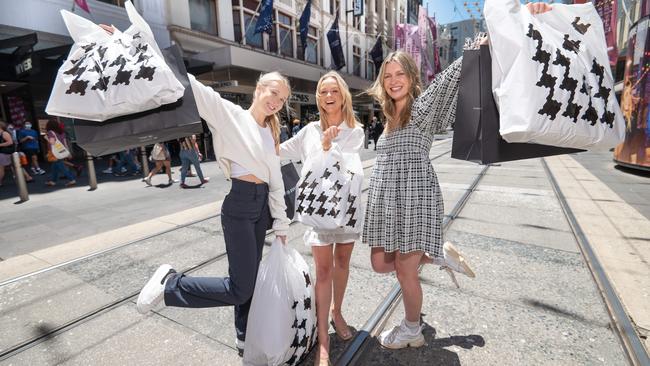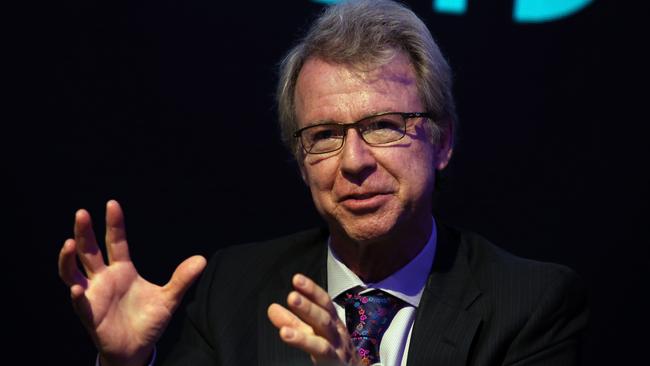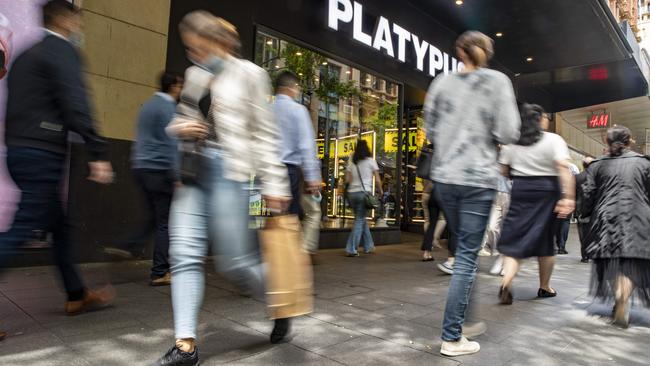Spending splurge since the start of the year tipped to run out of steam by November
A funny thing happened to the consumer on the way to the shops this year: they kept on spending money despite rising interest rates and inflation.

A funny thing happened to consumers on their way to the shops: they kept spending money.
Great wads of cash were thrown at restaurants and cafes, either dining out or ordering in food via delivery platforms such as Uber Eats or Menulog.
And they spent up at department stores too, buying strongly to fill their homes with fashion, clothing and homewares.
Take the normally staid furniture category, for example, where normally sales in Australia would be growing at 3 per cent a year; that sector is displaying growth of about 11 per cent.
And this is despite four interest rate increases since May, soaring inflation and fears of a hard landing for the economy as it follows the world into possible recession.
It is a rare combination of ills to plague the Australian shopper – and yet, through June and July, they kept spending money.
From constricted budgets due to rising rates to possible war in the region and actual war in Europe, there have been plenty of reasons not to shop. But there seems to be a lag between reality and consumer behaviour.

“It is often the way,” says AMP chief economist Shane Oliver. “It seems to me that consumers are starting to deal with increasing interest rates and that is evident in collapsing consumer confidence levels – with those levels often associated with recessions.
“But for now they are still spending and that is evident in retail sales numbers, business surveys … and I think that is partly because the jobs market is still strong, and so while people are feeling nervous at least they still have got good jobs and there are plenty of jobs going for higher salaries if they want to move.”
Now economists and analysts sense that the spending splurge is about to end, and will begin to run out of steam in November. Some retail experts pinpoint the Black Friday sales at the end of November as the likely turning point for consumers and the retail sector.
A string of interest rate rises, the likely end to the fuel excise subsidy in September, and household savings built up over Covid-19 – and severely depleted by November – could leave the consumer with an empty tank.
But what a ride the consumer and retailers have had.
The latest data from the Australian Bureau of Statistics shows spending is finding its way into dining out and restaurants, home furnishings and fashion.
Queensland, Victoria and Tasmania are positively humming with consumer activity.
The bureau’s newly created household spending indicator – which uses bank transactions to gain a glimpse into consumer spending – shows spending increased 10.2 per cent in June against the same month last year. Household spending increased for both services (up 15.9 per cent) and goods (up 5 per cent).

And for June, when households had already experienced two consecutive rises in interest rates and inflation was spiralling higher, spending on transport rose 22.7 per cent, hotels, cafes and restaurants was up 17.1 per cent and clothing and footwear spending was up 16.3 per cent.
ABS head of macroeconomic statistics Jacqui Vitas says that in the most recent survey, the biggest-spending states – compared with the same time last year – were Queensland, Victoria and Tasmania. In Queensland, spending on hotels, cafes and restaurants was up 25.6 per cent, and in Tasmania it was up 27 per cent.
The latest data – as well as recent trading updates from major national retailers like JB Hi-Fi, The Good Guys, Myer and David Jones – reveals that since January consumers have splurged at the cash register.
This continued in May, when the RBA’s first cash-rate rise came and the central bank warned of more to come.
With the reporting season lifting a gear next week when the biggest retailers report their full-year financial results, all eyes will be on trading updates and what retailer CEOs have seen at their stores since July.
The outlook for July and August is still expected to be bullish – especially as retailers are cycling last year, when lockdowns and store closures dented spending. What economists and analysts sense, however, is that consumers will begin to slash their spending heading into Christmas.
“The cost of living for the consumer is rising. However, employment remains strong, the labour market remains strong and household savings provide a buffer,” says UBS retail analyst Shaun Cousins. “And we believe it takes some time for the cumulative effects of the increasing cost of living to really play out to their (consumer) spending.

“One of the key catalysts we see as weighing on the consumer, more probably from a sentiment perspective … is actually the return of the fuel excise back to its full level.
“We see petrol as a purchase that is generally a grudge purchase. It’s a product where the consumer sees the price multiple times a day.
“It can have a greater impact on their broader willingness to spend beyond the proportion of spending that is fuel, which is not high, but we think that could be a catalyst to weigh on sentiment.”
Mr Cousins expects consumers to pull back on spending from November.
“We’ve chosen November more because we think that it takes some time for the cumulative effects of the cost of living pressure to rise,” he says.
“It could happen in October. Part of the reason we are thinking about November is also November 2020 and November 2021 were strong trading periods and we are thinking very much about November 2022 on the prior period; the stores reopened in November 2021 and during October 2021. And so you’d start as a retailer to cycle tougher numbers on a year ago,” he adds.
“But we do get more cautious about the back end of the year. November is sort of the first clear month where stores are fully open at that time.”
This view of the sector has led UBS to adopt a bearish view of discretionary spending and a more positive view of supermarkets. “Despite reasonable full-year 2022 expected results and the start to the first half of 2023 expected, the rising cost of living is forecast to weigh on the consumer, especially from November onwards,” the investment bank said in a note to clients.
“Within consumer discretionary, we retain a preference for retailers that focus on the young and affluent and market-share winners.
“Supermarket retailers should benefit from food inflation, which continues to rise, while concerns on volume remain, yet are moderated as the shift to out-of-home consumption is less due to the rising cost of living.”
Mr Cousins’ “buy” ratings for the retail sector as the economy starts to turn include Domino’s Pizza, Metcash, Premier Investments, Super Retail Group, Treasury Wine Estates, Universal Store and Wesfarmers.
JPMorgan retail analyst Bryan Raymond looks to Black Friday sales on November 25 as possibly the last hurrah for consumers.
“We think retailers will likely continue to do well up until Black Friday,” he says. “Black Friday is a growing event, and remains one that’s getting a lot of investment from retailers and suppliers.
“And so we think that even that will likely go well, but then after that is when we see the risks building.
“Black Friday is … taking share from Boxing Day, Christmas sales, so people will gravitate to the sale event because of the prices being offered – but also to buy their Christmas presents early – and so it’s a bit of a pull forward there. Think about December as probably the key risk period because we are now going to be (comparing with) a period (last year) where all stores were open, and in Australia last year no one was travelling, borders were still pretty much closed.
“I think basically from December onwards and particularly next year, there’s a risk around sales across the board – particularly for the non-food space it’s going to be more pronounced.”
JPMorgan expects many retail categories to have their lowest sales growth in June next year and some retail categories, such as furniture, to have double-digit sales declines. “Now that’s actually not a shocking result if you look at pre-Covid levels. A lot of these sectors are still delivering fantastic sales growth, so while the headlines might look more negative, in our view the absolute level of sales will still be quite strong – it’s just it is (comparing to) an incredibly strong period before,” Mr Raymond said.
He views the retail sector as going through a slowing sales trajectory from the end of the year, and most pronounced in more discretionary categories. “The categories that have performed the strongest over the past 12 months are the ones we are likely to see the largest declines in,” Mr Raymond said. “For example, we have got furniture and hardware that are both up about 11 per cent per annum for three years … normally it would run at growth rates of more like 3 per cent. They still haven’t seen any normalisation yet so I think those will obviously have to see a bit of a reversal from the very strong growth they’re seeing at the moment.
“But the important point to note is that as you go forward into next year, even when we have got growth expectations at their lowest, so furniture for example … we’ve got that coming back to circa 4 per cent to 5 per cent.
“In order to go from 11 per cent growth for three years and then to 4 or 5 per cent, you need a big negative to get there and that is the way we are thinking about these retail sectors.”
According to JP Morgan, the furniture sector could hit its lows in April with a sales retreat of 14 per cent. Hardware would be lowest around April and May with a 9 per cent sales fall, while consumer electronics sales could be down as much as 10 per cent. “From there on, we are actually reasonably constructive on the retail sector and sales should go back to positive by mid-2024, early 2024, in most of these sectors, and then we kind of normalise things from there,” Mr Raymond said.








To join the conversation, please log in. Don't have an account? Register
Join the conversation, you are commenting as Logout